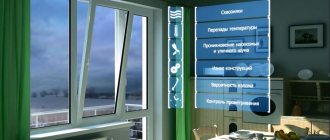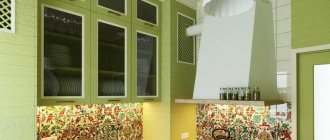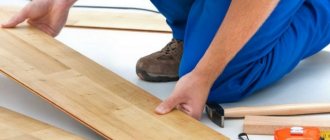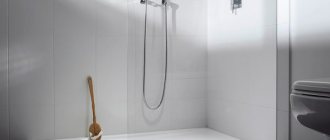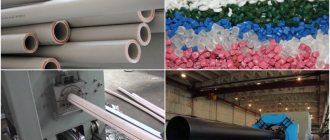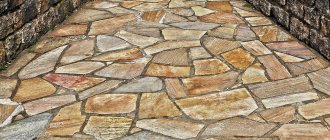Hello friends!
I won’t write a lot of words today, but will get straight to the point. A convection grille in the window sill helps prevent condensation (which, in turn, leads to the formation of fungus). This happens due to impaired air circulation in the room and due to increased humidity levels.
The installed grille relieves a person of this problem: the air heated by the radiator freely flows through it up to the window, and when cooled at the opening, it falls down.
Now let's take a closer look at why it is important to install grilles and what causes condensation on the windows.
According to SNiP, central heating radiators should be located under the windowsill. Their task is not only to warm up the room, but also to heat the window opening - in order to avoid the appearance of condensation. Therefore, the radiator always protrudes slightly relative to the window sill - so that warm air from it can rise up to the window.
However, now the methods that were relevant in the past are often violated:
- During repairs, window sill boards of greater depth are installed, completely covering the radiator.
- Sealed plastic windows are installed.
Old wooden frames, which were installed in houses built in the second half of the last century, had gaps and cracks. Through them, air freely entered the rooms and was removed through ventilation shafts - that is, there was natural circulation.
Before the “2000s” (when people began to massively replace old, cracked wooden windows with new PVC structures), there were no such problems with condensation. And the rooms were not so stuffy - again, due to the flow of fresh air through the cracks.
Now people often forget that they need to worry not only about the beauty and tightness of the window, but also about normal ventilation. There are two ways to solve the problem:
- Install a supply ventilation valve in the window.
- Install the ventilation grille in the window sill.
Ideally, these methods should be combined: if there is a grille in the window sill, this will not solve the problem of stuffiness in the room.
More on the topic Plastic windows A class
Types and characteristics of products
Regardless of which window sill the grille is chosen for (plastic, wood, stone), it can be made from the following materials:
- Aluminum.
- Steel.
- Tree.
- Plastic.
The shape of the bars is rectangular (like the window sill). The most common frame sizes (in millimeters) are:
- 80 x 800.
- 100 x 800.
- 100 x 600.
- 80 x 480.
- 100 x 500.
- 80 x 500.
Based on the control method, products can be divided into 2 categories:
Non-adjustable – having fixed slats.
Adjustable - having slats that can be tilted, thereby letting more or less air through and directing it.
Products can also be divided according to their location relative to the window sill:
- Flush with the surface.
- Protrude relative to the surface.
As for the shape of the holes, most often they are made in the form of slits. Much less common are window sill grilles with round perforations, or any other shape, even some kind of figured decorative one, with ornaments or patterns.
Trying to make a screen for the radiator yourself
Screen-grid
A simple radiator screen consists of a panel with wooden grilles in a frame. The slats are located in any direction: horizontally, vertically, diagonally. You can also conceive a cellular lattice, for which the slats are laid in the opposite direction. The angle at which the slats are located can be not only straight.
Screen grid for battery
Diagonal arrangement of slats on the screen for the heating radiator.
As an option, the screen is made in the form of blinds. It will resemble traditional wood shutters. The slats in the frame are located at an angle to the base. This is done using parallel cuts. Taking into account the size of the slats, two cuts are made with a hacksaw, and the excess wood between them is removed with a narrow chisel. Such recesses are made at the desired angle and according to the number of prepared slats.
Screen in the form of blinds for the radiator
First, a frame is mounted according to the size of the radiator. After this, slats are attached to it. Just be sure to use dry material so that it does not dry out or warp during use. All parts are carefully sanded, strengthened with glue or self-tapping screws, primed and coated with the chosen varnish or paint.
Screen box
It’s easy to make a screen with your own hands for a heating radiator from MDF material. To do this, knock down a box under the existing battery and cover it with a decorative panel. You can purchase different options for the color and shape of the holes. Or order a drawing made according to your sketch on a special machine. You can also make simple holes yourself.
MDF screen box
The following tools may be required for work: a drill with drills and a circular saw, a hacksaw, a furniture stapler, and screwdrivers.
As for materials: we choose chipboard or MDF, metal mesh, self-tapping screws and screws for fastening, glue, two furniture legs.
Tools for work
Work is being done to create a screen for the radiator in the following sequence:
- We take measurements from the battery. We add 7-10 cm to the existing width, and 3-5 cm to the height. We measure the required values on the prepared plate and cut along the resulting lines with a circular saw. We get the outer side of the screen.
- For depth, add 3-4 cm to the top of the box; we know the width. We cut according to the same principle. Now we know the dimensions of the side parts of the future product. We cut out these parts too.
- We cut out the necessary holes in the front part, having previously drawn them with a pencil on the plate. Patterns can be of any shape and depend on the imagination and skill of the performer.
- On the wrong side we attach a thin metal mesh covering all the holes. This can be done with self-tapping screws or using liquid nails.
- We connect all the blanks using metal corners, placing them inside the box and using the same self-tapping screws or screws for fastening.
For stability, legs are attached to the bottom of the screen.
Installation of screens on heating radiators.
Of course, this instruction is quite schematic and does not explain all the points. But the main direction of the work can be understood. The rest depends on the courage and desire of the home master.
How and what to choose?
The main rule when choosing a ventilation grille for a window sill is to focus on its length and the length of the battery.
The best option: choose a grille that is approximately the same length as the radiator. This can be either 1 long lattice or several shorter ones. A product that is not long enough and located on one side of the board simply will not protect against condensation in the other part of the window.
With this rule, one more thing should be followed: pay attention to the open cross-section of the grille (for reference: this is the area of the holes through which air can pass). For most convection models, this characteristic ranges from 0.42 to 0.6 - which will be quite enough to solve problems with condensation on windows.
By the way, for those who plan to put something on the windowsill, it is not recommended to choose grill models with holes that are too large. In this case, small things may fall through them, and debris will accumulate under the batteries.
If the window sill board is not used in any way, you can choose ventilation grilles with a large open cross-section (large size of the notches) - up to 0.9. This way, more air will flow through the holes, which means there will be less chance of condensation forming.
Installation
The first stage of installation of in-floor convectors is always the preparation of a special niche for installing the device. In the case of convectors built into the floor, this can be either a regular concrete screed or installation in a raised floor. Both installation options for such convectors are possible only if the renovation of the room has not yet been completed and the floors have not yet been installed.
When choosing a niche for heating units, you should pay attention to the following indicators
- Hole depth. The depth of the niche should be approximately 10-15 mm greater than the height of the device itself. This figure is most often indicated by manufacturers in the user manual for individual models. Safety millimeters will allow you to correctly align the device box, as well as the grille, with the floor level.
- Niche width and length. Here experts advise adding 5 to 10 mm to the dimensions of the device - this way you can properly strengthen the body of the device and will not experience difficulties when laying communications.
- Distance from windows and walls. Experts recommend leaving 5 to 15 cm between the installed unit and the window (or panoramic windows). If we are talking about the distance from the device to the walls, then here you should maintain from 15 to 30 cm to avoid the formation of mold in the corners and heat accumulation only on the walls.
- Curtains. Curtains or tulle are an indispensable element in most style decisions. Keep in mind that they should not impede air circulation, therefore, they should not block the heaters from the room. The ideal option for built-in convectors would be small and light country or Provence style curtains, blinds or rollable fabric models.
- Insulation and heat loss. Incorrect placement of the heating device leads to a decrease in the heating efficiency and the efficiency of the device itself. When installing, be sure to use insulating material, otherwise all the heat generated by the unit will heat not the room, but the next 1-2 square meters of the floor
- Sustainability. The device is mounted to a state of complete stability and stability. To adjust a comfortable height, special supports or brackets can be used. To further stabilize the device in the niche, various fixing working solutions can be used. Such stabilization of the position of the unit is necessary for the future installation of pipe communications, which, with the slightest displacement of the wiring, can lead to flooding of the room and damage to the floor covering.
When installing a water-powered convector built into the floor, there are only 2 ways to connect communications.
Flexible. This connection involves the use of flexible communications or hoses that supply coolant to the heat exchanger. The clear advantage of this connection is that the communications can be easily removed while cleaning the unit, and then freely secured back. The disadvantage of such a connection is the relative fragility and vulnerability of flexible communications.
If you connect an electric convector built into the floor, you just need to lay the wires correctly and connect the device to a 220-volt network. In this case, grounding is not required, since communications in modern floor convectors are manufactured a priori with grounding. Make sure that all wiring is hidden under the floor - this way you will protect yourself from injury, and the device itself from premature failure.
Additional tips for installing floor-mounted convectors.
- Metal-plastic pipes or communications are considered the best material for piping built-in convectors. They simultaneously have sufficient strength for long-term use and flexibility for convenient placement in any installation conditions.
- Communications, regardless of their type, should be embedded in a concrete covering or covered with a raised floor. There should be no unnecessary connections or switches in this area of communications laying, which is why purely metal options are impractical here. In the case of laying a raised floor, it is possible to install communications of any type, however, the recommended materials here remain metal-plastic or polypropylene.
- When installing the unit and subsequent laying of the grille or decorative frame, gaps and free space may form between the flooring. Experts advise filling it with silicone.
- Installation of the circuit pipes to the device should be carried out using special union nuts (they are also called “American”).
About grating materials
As for the material: the most expensive option is steel. However, its use is not mandatory - plastic, aluminum, and wooden gratings will do the job equally well. They all have their own characteristics:
- plastic is the cheapest, but in white it fades in the sun and changes shade;
- wood is a less common option, which costs more than plastic and aluminum, and is more demanding to maintain;
- aluminum is the best option: not susceptible to UV radiation, and not too expensive.
You should also pay attention to the location of the grille relative to the surface: ideally, it should be flush with the window sill. Protruding elements, firstly, catch the eye, and secondly, they do not allow the window sill board to be fully used (for example, as a “shelf” for flowers).
More on the topic Window sills made of artificial stone
Approximate price minimum for some grilles:
- aluminum, non-adjustable, 80 x 800 mm: from 1100-1200 rubles;
- aluminum, adjustable, 80 x 800: from 1200;
- aluminum, non-adjustable, 100 x 600: from 1100-1200;
- aluminum, non-adjustable, 100 x 800: from 1200-1300;
- plastic, unregulated, 80 x 800: from 800-1000;
- plastic, unregulated, 100 x 500: from 700-800;
- wood, unregulated, 90 x 500: from 2500.
And some companies have now even begun to produce window sills with already installed grilles. This option is not always suitable - since their location may not correspond to the location of the radiator.
Installation stages and rules
You can install a ventilation grill with your own hands in a plastic or wooden window sill; installation in a concrete “board” will require much more experience and other tools.
Otherwise, the grille is installed in a concrete window sill in exactly the same way. Let's consider the nuances and stages of work for a plastic or wooden board and the same lattice. It is not necessary to remove the window sill to carry out the work. The direction of the slats (if the holes are slot-shaped and the slats are installed at an angle) should be towards the window.
Tools you will need:
- Marking tool (marker, pencil).
- Jigsaw or grinder.
- Glue for plastic (optional).
- Any heavy object that can be used as a press (needed if the lattice will stick).
- Drill.
The diameter of the drill bit must be larger than the width of the jigsaw blade (so that it can fit into the drilled hole).
Stages of work
The process itself looks like this:
- Mark the place where the grille will be located.
- Holes are drilled in the corners.
- A jigsaw blade is inserted into the hole and a mounting hole is cut out for the grill itself.
- The product is installed in the hole for “trying on”.
- The edges of the hole are coated with glue.
- The grille is installed in place and pressed.
- The glue squeezed out along the edges is removed.
- Any heavy object is installed on top of the grate as a press.
- Metal products (as well as some plastic and wooden ones) are attached not with glue, but with bolts.
Using glue is not an ideal solution - in this case the structure will be solid. If necessary (for example, if the plastic lamella breaks), the grille will have to be torn off from the surface.
You don’t have to use glue if the groove is perfectly even: so that the lattice “sits” tightly in it without moving. In this case, if necessary, it can be pulled out - for replacement, repair or cleaning.
Source: ventihome.ru/elementy/reshetki/ventilyacionnaya-reshetka-v-podokonnik-konvekcionnaya-dlya-batarey.html
Summarize
Such elements are a fairly convenient way to get rid of dampness and fungus on slopes and double-glazed window frames. And the fact that the cost of plastic products is low, and installation is quite simple, only adds confidence in the necessity or simply profitability of their installation.
Sources
- https://ventihome.ru/elementy/reshetki/ventilyacionnaya-reshetka-v-podokonnik-konvekcionnaya-dlya-batarey.html
- https://HomeMyHome.ru/ventilyacionnye-reshjotki-dlya-podokonnikov.html
- https://okna-comfort.ru/ventilyatsia/reshetki
- https://oventilyacii.ru/otoplenie/ventilyatsionnye-reshetki-dlya-batarej.html
- https://seti.guru/ventilyatsionnyie-reshyotki-dlya-podokonnikov
- https://stroy-podskazka.ru/furnitura/podokonniki/ventilyacionnaya-reshetka/
How do you like the article?
Sergey Vladimirovich
Ask a Question
What causes condensation to form?
The concept of condensation refers to water that settles on window glass and frames due to excess presence in the air.
Most often, the occurrence of condensation is provoked by the following factors:
- operation of heating radiators;
- room temperatures are too high;
- making serious mistakes when installing windows in openings;
- lack of ventilation or incorrect operation of these products;
- installing a window sill whose width is too large and covers the radiators, resulting in water diffusion;
- high thermal conductivity of walls and window structures.
In most situations, the heating radiator is placed directly under the window sill tabletop, therefore, this element gets very hot and causes condensation. To get rid of this trouble, you need the correct installation of a ventilation grille that is built into the window sill.
More on the topic Supply valve for plastic windows
Eliminate fogging of plastic windows
Our company provides window defogging services. Our specialists work with special equipment and various devices (for example: a device for measuring room humidity).
To successfully eliminate increased condensation on plastic windows, craftsmen will conduct a thorough examination of all premises to identify the true causes of the appearance of unwanted moisture. Research is being carried out in several directions:
- checking the draft of ventilation shafts,
- measuring the ratio of window sills to the location of heating devices. The width of the window sill should not overlap the battery,
- checking the quality of installation of window structures.
In our company we carry out the following measures to “fight” fogging:
Promotion:
Gifts for all active clients
Window sealing
In order to prevent windows from fogging up, you can simply try to seal them: insulation with polyurethane foam (propenka), waterproofing external installation joints (Stiz-A).
Installation of window supply valves
Climate valves are responsible for ensuring the flow of outside air. These devices restore natural ventilation, which is often disrupted by the increased tightness of modern windows.
The valves are equipped with automatic dampers that independently regulate the air flow, controlling the level of humidity (cooking, using the bathroom), which causes condensation.
| Photo | Brand | Short description | Price with installation |
| AEREKO EMM Hygro-regulated window supply device. | 2 ways of air supply (vertical, inclined). Equipped with an ASAM visor (protection against water and insects). Color white, brown. | 5600 rub. | |
| AERECO ENA2 Hygro-regulated window supply device. | Ideal installation for windows and roller shutters. Equipped with a special spacer to reduce noise (acoustics up to 42 dB) and an automatic open/close switch. | 6610 rub. | |
| AERECO AS External visor. | Protects the window from water and maintains optimal air flow. The internal damper protects against pressure changes (suitable for high-rise buildings). Equipped with an insect screen. | 500 rub. | |
| A-EMM, A-ENA External visors in assortment. | Acoustic visors. They perform sound insulation with a maximum valve opening of up to 47 dB. Two colors, white, brown. | 1000 rub. |
Installing ventilation grilles in the window sill
The grilles ensure constant air circulation from the battery to the window opening and heat the glass.
| Photo | Description | Price |
| Ventilation grille built into the window sill. Size: 400 X 150 mm; Color: white, brown; Material: plastic. | 1500 rub. |
Window convector installation
The window convector is installed in the wall opening under the window. Thanks to this, a targeted flow is formed from the battery to the window, creating a “warm curtain” of the window unit. Ice, condensation, and fungus will “leave” your windows forever.
In addition to the functional load, the installation of valves, grilles, convectors and other devices will not worsen the appearance of the room. All devices look very stylish, made taking into account modern design developments. We carry out all work carefully, efficiently, and with a guarantee.
Replacing window sills with more suitable widths
Often, along with new windows, new wide window sills are installed, instead of narrow, old ones. Sometimes it is so wide that it covers the entire battery. We will choose the optimal width of the window sill.
Replacement of PVC slopes
We dismantle poorly installed slopes, insulate them, and install new ones from sandwich panels.
Photos of the installation of slopes of plastic windows
Features and types
Modern manufacturers offer a wide selection of grilles designed to provide ventilation for window sills. They can differ from each other in many ways:
- material of manufacture;
- color;
- form;
- size;
- design features;
- place and method of installation.
The main task of any ventilation grille is to uniformly distribute the warm air flow and then direct the required amount of oxygen.
Materials such as steel, aluminum, durable plastic, and natural wood can be used to produce convection grilles.
Steel products are the most durable, while wooden ones are the safest and cleanest from an environmental point of view. Plastic and aluminum products have proven themselves to be the most affordable.
At what price can you buy ventilation grilles for a window sill - price review
Ventilation grilles for window sills can be purchased at building materials stores and retail chains that deal with similar products and also specialize in sanitary equipment. In addition, similar products are offered by online stores of various types, both working with building materials, and with plastic products and elements of decorative finishing of premises.
From companies engaged in the production of interior decoration elements, you can order ventilation grilles according to individual sketches
The following table shows the cost of individual models of ventilation grilles as of the second quarter of 2021:
| Image | Model and material of manufacture | Overall dimensions, mm | Average cost (as of May 2021), rub. |
| ERA 4513 (plastic) | 450×131 | 179 | |
| Vents МВ450/2 (plastic) | 450×70 | 151 | |
| Vents МВ350 (plastic) | 350×35 | 182 | |
| Vents МВ430/2 (plastic) | 450×70 | 137 | |
| Vents МВ450 (plastic) | 450×15 | 91 | |
| SETE (aluminum) | 480×60 | 370 | |
| GTV (inox) | 500×100 | 850 | |
| Werzalit (aluminium) | 800×80 | 1850 | |
| AIRO-LD (aluminium) - adjustable | 340×61 | 294 | |
| AIRO-PE (aluminium) - perforated | 700×352 | 763 |
The presence of a large number of models made from various materials and in a wide range of overall dimensions allows you to choose the necessary product for a specific location, and the ease of installation allows you to do the installation yourself.
Installation location
Ventilation grilles can be installed in two ways - external and internal.
Products intended for installation indoors directly above the battery must have an aesthetically attractive appearance, as well as not very large dimensions, so as not to reduce the usable area of the living space. The material used can be anything, the main thing is that it harmonizes perfectly with the overall style and is of high quality.
External grilles must ideally withstand harmful environmental influences, so it is best to choose aluminum options. In addition to their main task, such products also effectively prevent the penetration of dirt, dust and insects.
Depending on the type of structure, there are adjustable and non-adjustable options. Adjustable ones have built-in movable blinds.
Important Requirements
The main task of each ventilation grille is to ensure the fastest possible rise of warm air coming from heating appliances to the windows through the window sills. Therefore, the location for it must be chosen as close as possible to the window structures.
If the window sill is large, the convection grille should be installed strictly above the heating radiators. It is important that the grille openings coincide with the dimensions of the upper section of the heating radiator.
The sections (holes) of the grating may differ in shape, but the value of the open section, that is, the total sum of the areas of all holes must be no less than 0.42 and no more than 0.60 l/s.
Such indicators are quite sufficient for effective ventilation, and besides, small parts cannot fall through such openings.
Floor-wall convectors for water heating
Based on their location, convectors are divided into:
- In-floor.
- Floor-standing.
- In-wall.
- Wall-mounted.
- On the window sills.
Floor-standing devices are mounted under the window (equipped with legs), wall-mounted ones are installed in recesses and wall openings.
They can be with side and bottom connections.
Separately, we can mention window sill convectors. These are miniature heaters (from 11 cm deep, for installation in a window sill 2.5 cm thick) that can be built into any window sill and they will be practically invisible.
At the same time, the units are quite powerful (most often they have a built-in fan to increase the heat transfer rate). Such devices protect your home from drafts and cold air falling from the windows.
Example: The Eva parapet heater comes complete with an oak window sill and costs 28-40 thousand rubles.
There are floor-standing convector models made in the form of warm wooden benches.
How to install correctly
According to the new rules, the design of all new buildings is carried out taking into account ventilation grilles.
But in most cases, you have to install these products yourself. Most often, such gratings are easily glued with ordinary construction silicone. It is recommended to attach plastic ones using a special glue for PVC products. Other important materials and tools include a drill, electric jigsaw, and marker.
Using a marker, the area of the window sill intended for cutting is marked, and then one small hole is drilled in each corner.
Next, the excess area of the window sill is carefully sawed off, and a grille is installed on this area, followed by a strong fixation. To make the glue dry faster and more reliably, it is recommended to temporarily place some suitable press directly on the grille.
Useful tips
There are several important recommendations that will prevent condensation from occurring.
For wide window sills, installing ventilation grilles is a mandatory step. The grilles must be cleaned or replaced regularly to ensure proper air circulation.
Try to keep the number of plants in pots on windowsills to a minimum, as frequent watering promotes condensation.
If you are not confident in your abilities, it is better to entrust the installation of ventilation grilles to professionals.
Source: klivent.biz/ventilyaciya/reshetka-v-podokonnik.html
Condensation and ventilation
If condensation occurs, experts recommend reducing the humidity in the room and moving heating radiators further away from the window sills so that warm air flows onto the glass unit.
But when it is not possible to move the battery, you can resort to a new method invented by manufacturers - installing ventilation grilles in the window sill panel.
The manufacturer of this product offers grilles of any shape and size, as well as in any color shades. They can be installed on window sills made of absolutely any material.
Wood, plastic, porcelain stoneware - ventilation holes covered on window sill panels of these types with grilles look aesthetically pleasing and do not spoil their appearance at all.
The purpose of these products is to achieve natural and constant air circulation in the window area. There are even grilles with special adjustable slats that allow you to change the direction of air flow, which is very convenient.
Benefits of the latest technology
Infrared film is used not only for heating window sills; it is used in systems of heated floors and baseboards. Installation of this device is simple, and no special tools or skills are required.
The heating film has the following qualities:
It heats up in a very short time: one or two minutes, and it is in the operating temperature range. It warms up efficiently, evenly, affecting the entire area. Electricity consumption is striking in its economy - 20 W. Three window sill plates - three 20 W each - the energy consumption is equal to one incandescent light bulb. Excellent aesthetic appearance. It does not damage the base at all, since it does not require either a cement screed or an adhesive solution for installation: it is applied to the surface using a dry method
This is very important: if it fails, there is no need to do “dirty” work. Replacement will require about an hour of free time. Sold in kits that include all the necessary accessories and elements for its installation: special tape, mounting wires, an insulating block, several clamps. To control such a heating system, a convenient electronic control has been created
There are both simple hand-held devices and programmable ones with an LCD display. Invisible to prying eyes. It is more convenient to measure thickness not in millimeters, but in microns.
